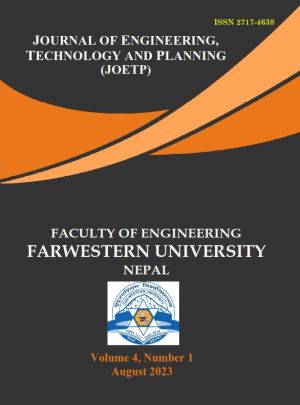Effect of Surface Characteristics and Rainfall in Infiltration Rate: A Case Study of Kaligandaki River Basin
DOI:
https://doi.org/10.3126/joetp.v4i1.58445Keywords:
Hydrological Modelling, HEC-HMS, Kaligandaki River Basin, Landuse and infiltration, Rainfall and infiltrationAbstract
Study of infiltration characteristics is crucial for effective watershed management, as it helps determine the water availability for crops, the need of irrigation, groundwater recharge, and surface runoff. This study is aimed at identifying the relation between infiltration rate and surface characteristics as well as rainfall rate in the Kaligandaki River basin of Nepal using Hydrologic Modelling System (HEC-HMS). HEC-HMS is a physically based, semi-distributed model that uses the weather and spatial information of soil and landuse of the basin for deriving the inputs for the model. A hydrological rainfall-runoff model is developed for the Kaligandaki River basin, with outlet at hydrological station 420, Kotgau, of Department of Hydrology and Meteorology (DHM). The model was then validated at DHM station 420, Angsing, of Kaligandaki River. Model generated subbasin wise infiltration rates and existing landuse were analysed and it was found that sub-basins with dominant landuse as forest had high infiltration rate among prevailing landuse types. Conversely, low infiltration rate was observed for barren area, snow/glacier and grassland landcover type dominated subbasins. A positive correlation among rainfall rate and infiltration rate was seen with linear increase in infiltration rate for an exponential increase of average rainfall intensity. Infiltration rate was found to have positive correlation with the Hydrologic Soil Group types as suggested by NRCS. Moreover, the study signified a greater impact of landcover over soil types on infiltration rates. Whereas, no significant impact of basin slope on infiltration rate could be identified, which may be due to preclusion of multiple topographic features. Understanding the impacts of rainfall intensity and surface characteristics on infiltration enables proactive measures to mitigate the issues like landslide and reduce flooding and soil erosion by improving infiltration rates through surface condition assessment.
Downloads
Downloads
Published
How to Cite
Issue
Section
License
Copyright © Faculty of Engineering, Far Western University

